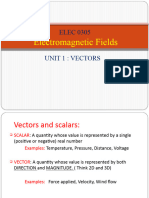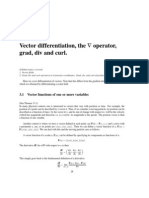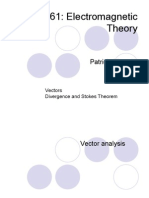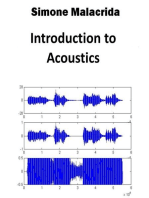Gradient Divergence Curl
Uploaded by
Naik LarkaGradient Divergence Curl
Uploaded by
Naik LarkaAny quantity that has both magnitude and direction is called a vector.
Velocity, acceleration,
and force are a few examples of mechanical vectors.
if you want to change only the magnitude of a vector without changing its direction, you will
go for the multiplication of the vector with a scalar quantity.
In case you want to create a new vector with a different magnitude as well as direction (than
the initial vector) then you have to multiply the initial vector with another type of
mathematical entity called a tensor.
The tensor is a more generalized form of scalar and vector. Or, the scalar, vector are the
special cases of tensor.
If a tensor has only magnitude and no direction (i.e., rank 0 tensor), then it is
called scalar.
If a tensor has magnitude and one direction (i.e., rank 1 tensor), then it is called
vector.
If a tensor has magnitude and two directions (i.e., rank 2 tensor), then it is
called dyad.
By representing the position and motion of a single particle using vectors, the equations for motion are simpler and
more intuitive. Suppose the position of a particle at time is given by the position vector .
Then the velocity vector is the derivative of the position,
A gradient is a vector differential operator on a scalar field like temperature. Every point in
space having a specific temperature. The gradient is a differential operator that gives you a
vector field, which in every point shows you in what direction in 2 or 3 dimensional space
the field of values is increasing the fastest. By moving in the opposite direction of the
gradient you are seeing the fastest decline of the scalar value, say temperature. By moving
perpendicularly to the gradient you are staying at the same scalar value. So gradient
operates on a scalar field to give a vector field.
Divergence is a differential operator that acts on a vector field to give a scalar field, so the
opposite of gradient. If I have a vector field like a gravitational field or an electric field, by
taking the divergence I get the scalar field that is proportional to the mass or charge density
"causing" that field. Everywhere in space where we do have gravitational or electric fields,
but where no mass or charge is located, the divergence is zero
If the point saw flux entering, hed scream that everything
was closing in on him. This is a negative divergence, and the
point is capturing flux, like water going down a sink.
If the point saw flux leaving, hed sniff his armpits and say all
flux was existing. This is a positive divergence, and the point
is a source of flux, like a hose.
The symbol for divergence is the upside down triangle
for gradient (called del) with a dot [ ]. The gradient gives us
the partial derivatives (dx, dy, dz), and the dot product adds
them together (xdx + ydy + z*dz).
Curl:
Let's go back to our fluid, with the vector field representing fluid velocity. The curl measures
the degree to which the fluid is rotating about a given point, with whirlpools and tornadoes
being extreme examples.
You might also like
- Unit-1 Electromagnetic Theory: Phy109 - Engineering PhysicsNo ratings yetUnit-1 Electromagnetic Theory: Phy109 - Engineering Physics54 pages
- Maxwell's Equations, EM Waves: If + + and + + Are Two Vectors, ThenNo ratings yetMaxwell's Equations, EM Waves: If + + and + + Are Two Vectors, Then39 pages
- Module - 4 (Maxwell Equations and EM Waves)No ratings yetModule - 4 (Maxwell Equations and EM Waves)18 pages
- Engineering Physics L-1: (Electromagnetic Theory) Quantum MechanicsNo ratings yetEngineering Physics L-1: (Electromagnetic Theory) Quantum Mechanics23 pages
- Electromagnetic Fields and Waves - Lorrain and Corson PDF100% (4)Electromagnetic Fields and Waves - Lorrain and Corson PDF383 pages
- Module-04 Maxwell - S Equations & EM Waves BPHYE102No ratings yetModule-04 Maxwell - S Equations & EM Waves BPHYE10217 pages
- B.Tech Physics Course NIT Jalandhar Electrostatics Lecture 1No ratings yetB.Tech Physics Course NIT Jalandhar Electrostatics Lecture 145 pages
- B.Tech Physics Course NIT Jalandhar Electrostatics Lecture 1No ratings yetB.Tech Physics Course NIT Jalandhar Electrostatics Lecture 145 pages
- W e Are Getting Less and Less Rigorous !No ratings yetW e Are Getting Less and Less Rigorous !5 pages
- Of (I.e., Diverging From) A Given Point. If Fluid Is InsteadNo ratings yetOf (I.e., Diverging From) A Given Point. If Fluid Is Instead1 page
- Mathematics For Physics 2023. Chapter 1No ratings yetMathematics For Physics 2023. Chapter 161 pages
- P361 Lecture2 Vector Differential Integral OperatorsNo ratings yetP361 Lecture2 Vector Differential Integral Operators28 pages
- Presentation On Del Operator and Its Applications100% (1)Presentation On Del Operator and Its Applications16 pages
- Divergence and Curl of A Vector Function: ObjectivesNo ratings yetDivergence and Curl of A Vector Function: Objectives13 pages
- Understanding Vector Calculus: Practical Development and Solved ProblemsFrom EverandUnderstanding Vector Calculus: Practical Development and Solved ProblemsNo ratings yet
- Systematically Repairing Key Relationships That Were Strained During Eisner's Reign As CEONo ratings yetSystematically Repairing Key Relationships That Were Strained During Eisner's Reign As CEO2 pages
- Chapters & Books 1) Stephenrobbins: Decision Making, Chane/Innovation 2) Fred Luthans: Motivation, Stress 3) I/V: Conflict ResolutionNo ratings yetChapters & Books 1) Stephenrobbins: Decision Making, Chane/Innovation 2) Fred Luthans: Motivation, Stress 3) I/V: Conflict Resolution1 page
- Conflict Management: Prepared By: M.Zafiruddin JunaidiNo ratings yetConflict Management: Prepared By: M.Zafiruddin Junaidi21 pages
- CH-011 Hazard Checklist For Highly Pressurized VesselNo ratings yetCH-011 Hazard Checklist For Highly Pressurized Vessel1 page
- Process Safety Management CH-523 Prof.: Zahoor@neduet - Edu.pkNo ratings yetProcess Safety Management CH-523 Prof.: Zahoor@neduet - Edu.pk70 pages
- MATSCI 210 - Lecture 4 - Entropic ElasticityNo ratings yetMATSCI 210 - Lecture 4 - Entropic Elasticity34 pages
- Buschow KHJ Handbook of Magnetic Materials Volume 06No ratings yetBuschow KHJ Handbook of Magnetic Materials Volume 06608 pages
- Separation of Radionuclides From High Level Waste Using Diglycolamide ExtractantsNo ratings yetSeparation of Radionuclides From High Level Waste Using Diglycolamide Extractants203 pages
- The Cosmic Mystery Tour Nicholas Mee download pdf100% (3)The Cosmic Mystery Tour Nicholas Mee download pdf66 pages
- 1 Semester, A.Y. 2018 - 2019 ME 452 - Heat Transfer Lecture 01 - Thermodynamics and Heat TransferNo ratings yet1 Semester, A.Y. 2018 - 2019 ME 452 - Heat Transfer Lecture 01 - Thermodynamics and Heat Transfer2 pages
- Evaluation of Hydrocarbon Heat Transfer Fluids: Standard Guide ForNo ratings yetEvaluation of Hydrocarbon Heat Transfer Fluids: Standard Guide For3 pages
- R - XXX - Bourns - Resettable Fuse, PPTC, MF-R SeriesNo ratings yetR - XXX - Bourns - Resettable Fuse, PPTC, MF-R Series6 pages
- Modul 2 Science Form 1 Chapter 2: Cell As A Unit of Life What Is Cell?No ratings yetModul 2 Science Form 1 Chapter 2: Cell As A Unit of Life What Is Cell?22 pages
- Pages From 16th+Mar+-+IUPAC+Nomenclature+ - +Top+50+NEET+Questions+ - +last+20+yearsNo ratings yetPages From 16th+Mar+-+IUPAC+Nomenclature+ - +Top+50+NEET+Questions+ - +last+20+years11 pages
- 1 Introduction To Quantum Mechanics Unit INo ratings yet1 Introduction To Quantum Mechanics Unit I12 pages
- J. Electrochem. Soc.-1981-Hall-740-6 - Electrodes For Alkaline Water ElectrolysisNo ratings yetJ. Electrochem. Soc.-1981-Hall-740-6 - Electrodes For Alkaline Water Electrolysis7 pages
- Natsir 2021 J. Phys. Conf. Ser. 1899 012039No ratings yetNatsir 2021 J. Phys. Conf. Ser. 1899 0120399 pages
- Experiment 1 Potentiometric Titration: Joan Marie Ilagan Joanne Sasondoncillo Ma. Kezia TayagNo ratings yetExperiment 1 Potentiometric Titration: Joan Marie Ilagan Joanne Sasondoncillo Ma. Kezia Tayag11 pages






































































































